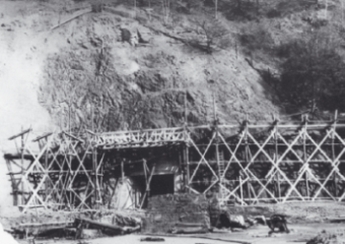The Institute of Thermomechanics of the Academy of Sciences of the Czech Republic was founded in 1953 – first as the Laboratory of Mechanical Engineering – and from the very beginning it has been oriented towards fundamental research in power engineering. Later, in 1962, this was codified by the decision of the Presidium of the Academy of Sciences, according to which the Institute´s main activities had to consist of fluid dynamics and heat transfer at high temperatures and high velocities, in gas dynamics of turbomachinery, and in thermophysical properties of gases.

 Location of the laboratory (Loc: 49°47'39.347"N, 14°18'18.232"E) and its bird´s eye view.
Location of the laboratory (Loc: 49°47'39.347"N, 14°18'18.232"E) and its bird´s eye view.
In 1962, only one high speed wind tunnel was operational in the Institute of Thermomechanics. It was an induction type wind tunnel built in 1959 for investigating 2D cascades. This wind tunnel could hardly cover the increased demands on the high speed research in internal aerodynamics in this country, and thus a decision was made to build a new facility for research into high speed aerodynamics.
The new facility had to serve a double purpose, i.e., the routine experimental investigation of transonic and supersonic turbine and compressor cascades, and, in particular, fundamental experimental research in transonic internal flows. From a detailed literature survey the concept of a new laboratory optimised from the economic, maintenance and operational points of view had emerged – the new wind tunnels were to be of the intermittent type, breathing atmospheric air expanding into a large vacuum storage.The required Mach number at cascade inlet or outlet had to be about 2, the minimum running time from 10 to 50 seconds, and the test section area about 160 x 400 mm. Thus ‚ the required mass flow amounted to about 20 kg per second, and the minimum volume of the vacuum storage to about 6000 m3. Inspired by some foreign designs, it was decided to look for a natural underground space, such as, e.g., mines, caves, etc. From about fifty places near Prague which satisfied these requirements the final choice was two almost parallel horizontal galleries of the former gold mines near the town of Nový Knín.


The gallery entrance Earthwork on the mouldered rock and concreting of the gallery portal.
Each gallery is about 1 km long. They were connected by digging out a connecting tunnel to provide an underground space with a total volume of 6300 m3 . The 65 meters of overlying, unweathered, compact crystalline schist makes the space leaktight. The outer layers of the mouldered rock were removed and the galleries were sealed by steel partitions embedded into the rock, and reinforced by a thick concrete layer.
The project documentation was completed in 1963 in two places – the laboratory building was designed by the Regional Design Office in Prague 7 following the specifications from the Institute of Thermomechanics, while all the technological equipment, as well as the transonic wind tunnel for 2D cascades was designed in the Institute of Thermomechanics itself. During the following years the Laboratory was extended and more facilities for research in transonic internal flows were added. The whole Laboratory was put into operation in 1965 [2].
In 1994 the Laboratory had to be extended to house a newly built wind tunnel for modelling flows in the atmospheric boundary layer. The Laboratory was rebuilt in its present form in 2004. In the same year a new extension was completed, and a considerable reconstruction of the whole technological equipment took place. After forty years of trouble-free operation the water-ring-vacuum pumps were replaced by new ones, the water supply was made independant by a closed cycle, and a new modular wind tunnel was built.



